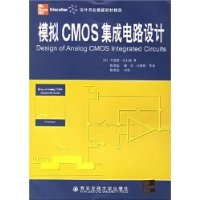 模擬CMOS積體電路設計[美]畢查德·拉扎維
模擬CMOS積體電路設計[美]畢查德·拉扎維【原出版社】 McGraw-Hill
【作 者】[美]畢查德·拉扎維 [同作者作品] [作譯者介紹]
【譯 者】 陳貴燦[同譯者作品] 程軍 張瑞智
【叢 書 名】 國外名校最新教材精選
【出 版 社】 西安交通大學出版社
【出版日期】 2003 年2月 【開 本】 16開 【頁 碼】 562 【版 次】1-1
【所屬分類】 工業技術 > 電工技術 > 電路 > 積體電路
【內容簡介】
本書介紹模擬CMOS積體電路的分析與設計。從直觀和嚴密的角度闡述了各種模擬電路的基本原理和概念,同時還闡述了在SOC中模擬電路設計遇到的新問題及電路技術的新發展。本書由淺入深,理論與實際結合,提供了大量現代工業中的設計實例。全書共18章。前10章介紹各種基本模組和運放及其頻率回響和噪聲。第11章至第13章介紹帶隙基準、開關電容電路以及電路的非線性和失配的影響,第14、15章介紹振盪器和鎖相環。第16章至18章介紹MOS器件的高階效應及其模型、CMOS製造工藝和混合信號電路的版圖與封裝。
本書是現代模擬積體電路設計的理想教材或參考書。可供與積體電路領域有關的各電類專業的高年級本科生和研究生使用,也可供從事這一領域的工程技術人員自學和參考。
【作譯者介紹】Razavi attended the Sharif University of Technology in Tehran and received a BS degree in Electrical Engineering in 1985. After moving to the United States, he obtained his Masters and PhD degrees from Stanford University in 1988 and 1992, respectively. Razavi initially worked as an engineer for AT&T Bell Laboratories and was an adjunct professor at Princeton University from 1992 to 1994. He returned to California in 1995 to work at Hewlett-Packard while an adjunct professor at Stanford University. In 1996 he became an Associate Professor and subsequently full Professor of electrical engineering at the University of California Los Angeles. Razavi specializes in telecommunications circuitry and his research involves work with data receivers, frequency synthesizers, and phase-locking and clock recovery for high-speed data communications.
From 1993 to 2002, Razavi served on the Technical Program Committees of the International Solid-State Circuits Conference (ISSCC), as well as for the Symposium on VLSI Circuits from 1998 to 2002. He has also worked as an editor for professional journals including the IEEE Journal of Solid-State Circuits, IEEE Transactions on Circuits and Systems I, and the International Journal of High Speed Electronics. Razavi was acknowledged with a fellowship in the Institute of Electrical and Electronics Engineers (IEEE) in 2003 "for contributions to high-speed communication circuits". He is a distinguished lecturer for the IEEE.
As of November 2008, the IEEE listed 231 journal articles for Razavi. He is also the author/editor of seven books and is recognized as one of the top 10 authors in the 50-year history of ISSCC.
【目錄】
作者簡介
中文版前言
譯者序
序
致謝
第1章 模擬電路設計緒論
1.1 研究模擬電路的重要性
1.2 研究模擬積體電路的重要性
1.3 研究CMOS模擬積體電路的重要性
1.4 本書的特點
1.5 電路設計的一般概念
習題
第2章 MOS器件物理基礎
2.1 基本概念
2.2 MOS的I/V特性
2.3 二級效應
2.4 MOS器件模型
習題
第3章 單級放大器
3.1 基本概念
3.2 共源級
3.3 源跟隨器
3.4 共柵級
3.5 共源共柵級
3.6 器件模型的選擇
習題
第4章 差動放大器
4.1 單端與差動的工作方式
4.2 基本差動對
4.3 共模回響
4.4 MOS為負載的差動對
4.5 吉爾伯特單元
習題
第5章 無源與有源電流鏡
5.1 基本電流鏡
5.2 共源共柵電源鏡
5.3 有源電流鏡
習題
第6章 放大器的頻率特性
第7章 噪聲
第8章 反饋
第9章 運算放大器
第10章 穩定性與頻率補償
第11章 帶隙基準
第12章 開關電容電路
第13章 非線性與不匹配
第14章 振盪器
第15章 鎖相環
第16章 短溝道效應與器件模型
第17章 CMOS工藝技術
第18章 版圖與封裝

